





Published on Feb 14, 2025
During recent years the main focus in whiplash research has been on rear-end impacts. Rear-end impacts have the largest risk of whiplash injury and therefore much effort is being spent on decreasing this injury risk. The total number of frontal whiplash cases may be higher, despite the smaller risk. Therefore, it is clear that also in frontal impact there is a need for improvement of whiplash protection.
In the first European Whiplash project the rear impact loading phase was the main focus. The research at the time was mainly limited to the loading phase of rear impact, since most of the proposed injury mechanisms assume whiplash to occur in the loading phase. On the other hand, some of the mechanisms of whiplash injury are suggested to originate from the rebound phase of rear impact. The rebound phase involves neck flexion, as in frontal impact. Therefore, the current research aims at reducing whiplash in frontal and oblique impact and studies the rear-end rebound phase.
In the end a test method will be proposed for evaluation of seats and restraint systems with respect to their whiplash protection. In this evaluation stage also a dummy is needed in order to assess the protection of a system. Part of the current project is to recommend on a dummy design that can be used for this purpose. Resulting from the findings in this concept, design guidelines for safer seat and restraint system design will be proposed.
Whiplash is a relatively common injury that occurs to a person's neck following a sudden acceleration-deceleration force, most commonly from motor vehicle accidents. Whiplash-a soft tissue injury to the neck-is also called neck sprain or neck strain. It is characterized by a collection of symptoms that occur following damage to the neck, usually because of sudden extension and flexion.
Hyperextension injury to the neck, often the result of being struck from behind, as by a fast moving vehicle in a car accident. Whiplash is a term used most often to describe the symptoms resulting from a car accident.
In order to understand how a whiplash injury occurs, you need to understand the structure of your body. The main support structure of your body is your spine, which consists of interlocking bones called vertebrae. Each vertebra is separated by a tough sack of jelly, called a disc.
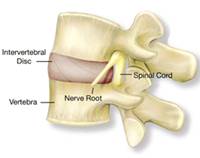
In minor cases, the quick jerk to the neck will only result is some muscle damage, which can heal. In more severe cases, the whiplash motion can strain and sometimes even rupture the squishy discs that separate the vertebrae. When the disc gets damaged, the injured person may experience extreme pain, numbness, tingling, and other unpleasant sensations in the neck.
It is the type of protection system that had been implemented in the front seats of the four wheel vehicle in order to avoid the neck injury.
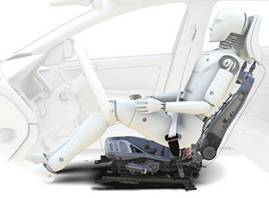
The WHIPS seat provides improved spinal support by virtue of its modified backrest characteristics and close proximity of the head restraint's position to the occupant's head.
WHIPS utilizes a specially designed hinge mount that attaches the back rest to the seat bottom
The Main Principle of Anti Whiplash Seat is to minimizing the degree of accident in the neck due to rapid movement of head and to design the seat's backrest and a head restraint that is sufficiently high and positioned close to the head are also important factors.
The principle is based upon the following parameters which has been explained below
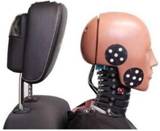
Here when the force is exerted on the Seat from the head of the persons due to sudden acceleration, the special type of the mechanism in the restraints will helps avoiding the equal and opposite force that exerts from the seat
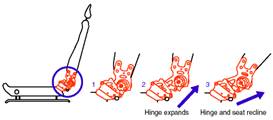

Before Exerting force After Exerting force
The Seat will made up of Wire Frames which reduces the impact of the forces that exerts from the human body
In an impact from the rear, immense force may be exerted on the vulnerable neck. The body is pushed forward and if the head does not accelerate together with the body, the neck can be over-stretched.
The 2005 Mercedes-Benz M-Class features an optional spring-activated system for whiplash protection. If the sensing system detects a rear collision within a specific impact severity, it releases pre-tensioned springs inside the head restraints. This causes the head restraints to move immediately forward by about 40 mm and upwards by 30 mm. This movement is designed to support the heads of the front seat occupants at an early stage, lowering the possibility of a whiplash injury.After activation, the head restraints can be unlocked and returned to the original position using a tool supplied with the vehicle. Mercedes-Benz plans on making this option available on all models in the future.
The pyrotechnic head restraint on the 2003 and newer BMW 7 Series is unique. On this system, a compressed gas cartridge at the base of the headrest frame activates during a rear collision, moving the headrest upward rather abruptly. The gas cartridge can be replaced, and the system reset if there is no further damage.
The initial concept was to develop a backset reducing active head restraint. For vehicle occupants it was observed that as the initial seatback angle increases, the separation point between the upper torso and seat back becomes lower. This is due to the occupant maintaining an upright head and torso posture. The idea was to develop a seat that conforms to the occupant prior to and during a rear impact at any seatback angle. Initial MADYMO model simulations showed that a modified head restraint would optimize its position relative to the occupants head. The concept seat model showed improved performance over a standard seat model. The results were directly due to the backseat being minimized.
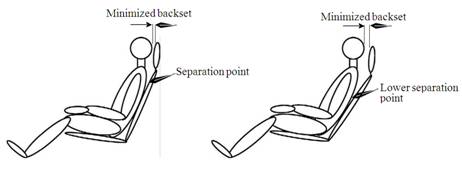
Initial concept seat schematic .Upright seatback angle on the left and more inclined angle on the right. This seat design attempts to minimize seatback angles
This conforming seatback concept was carried through to the final concept design. Refinements to the design minimized the backset and also the torso to seatback gap. The concept seatback attempts to mimic the curvature of the spine and maintains close proximity to the thoracic spine. The head restraint is also positioned so that height and backset are optimal. Any initial seat back angle will result in a properly adjusted seat configuration. The result is a seat that conforms to the occupant in all seating positions.
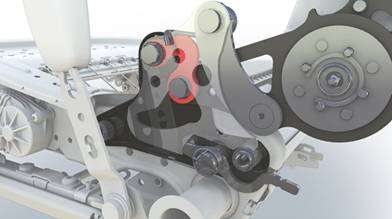
1. The Prince of Wales Medical Research Institute Barker St.Randwick NSW 2031 Australia . By Michael Yuen, Mr.and Lynne E. Bilston, Dr.
2. Vernon HT, Dhami MS, Howley TP, Annett R, "Spinal manipulation and beta-endorphin-a controlled study of the effect of a spinal manip. on plasma beta-endorphin levels in normal males," J Manip. Physio. Ther. 1995, 18 (8).
3. Croft A, Freeman M, "Correlating Crash Severity with Injury Risk, Injury Severity, and Long Term symptoms in Low Velocity Motor Vehicle Collisions," Med Sci Monit, Vol. 11(10), 2005.
4. "Injury of the Anterior Longitudinal Liegament During Whiplash Situation, Eur Spine J, Vol 13, Jan/2004, Pg: 61-68. And, Batterman S, Batterman S, "Delta-V, Spinal Trauma, and the Myth of the 'Minimal Damage' Accident," J Whiplash & Related Disorders, Vol 1.
| Are you interested in this topic.Then mail to us immediately to get the full report.
email :- contactv2@gmail.com |